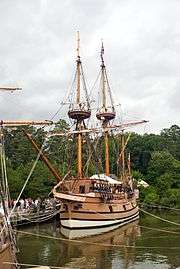Jamestown Settlement
 Recreated interior of James Fort | |
| Established | 1607 |
|---|---|
| Location | Jamestown, Virginia |
| Type | Living history museum |
| Website | Official website |
Jamestown Settlement is a living history museum operated by the Commonwealth of Virginia, created in 1957 as Jamestown Festival Park for the 350th anniversary celebration. Today it includes a recreation of the original James Fort (c. 1607 to 1614), a Powhatan Indian Village, indoor and outdoor displays, and replicas of the original settlers' ships the Susan Constant, Godspeed, and Discovery.[1]
It is located adjacent to the Colonial National Historical Park site, which includes Jamestown, the first successful English settlement on the mainland of North America, founded on May 14, 1607.[2] It is also adjacent and complementary to Historic Jamestowne on Jamestown Island, run by the National Park Service and Preservation Virginia, being the archaeological site where the first settlers lived. The Colonial Parkway connects all of these sites.
Background
Late in the 19th century, Jamestown became the focus of renewed historical interest and efforts at preservation. In 1893, a portion of the island was donated to Preservation Virginia[3] for that purpose, including the ruined church tower. In the early 1900s, a seawall was constructed with the intention of preserving the site around the original "James Fort", even though the actual location of the original 1607 fort was thought to be underwater and lost to erosion. In 1907, the Jamestown Exposition was held to mark the 300th anniversary of the founding of Jamestown, but the celebration was held at Sewell's Point in Norfolk, Virginia on the harbor of Hampton Roads, due to transportation and other considerations. The area came back into national prominence with the creation of the Colonial National Historical Park in 1940 and the uncovering of the old fort in 1996 by archaeologists of the Jamestown Rediscovery project.
Jamestown Festival Park
.jpg)
A return to Jamestown itself was considered feasible by 1957, in time for the 350th anniversary of the founding of the London Company settlement at Jamestown. Attractions were developed by the US National Park Service and the Commonwealth of Virginia which included the reconstructed Glasshouse, the Memorial Cross, and the visitors center. The National Park Service's Colonial Parkway was also completed in April, 1957 linking the Historic Triangle of Jamestown, Williamsburg, and Yorktown, including the construction of a land bridge to Jamestown Island.
The 1957 celebrations continued from April 1 to November 30 with more than one million participants, including dignitaries and politicians such as the British Ambassador and U.S. Vice President Richard Nixon. Full-sized replicas were constructed of the three ships that brought the colonists: the Susan Constant, Godspeed, and Discovery. They were built at a shipyard in Portsmouth, Virginia and relocated to nearby Glass House Point for the festival. There nearly 25,000 visitors at the Festival Park on October 16, 1957, and the highlight for many was the visit and speech of Queen Elizabeth II and Prince Philip. Queen Elizabeth lent a copy of Magna Carta for the exhibition. Other events in 1957 included army and navy reviews, air force fly-overs, ship and aircraft christenings, and an outdoor drama at Cape Henry, site of the first landing of the settlers in April 1607.
400th Anniversary
Jamestown Settlement was greatly expanded early in the 21st century as part of the Jamestown 2007 quadricentennial celebration.
Attractions
Galleries
The Jamestown Settlement galleries provide the setting for a varied collection of objects relating to the nation’s beginnings in 17th-century Virginia. The Jamestown-Yorktown Foundation collection has been developed to support the museum’s storyline and includes objects representative of the Powhatan Indian, European, and African cultures that converged in 1600s Virginia. More than 500 artifacts are exhibited at any one time in the galleries.[4]
Living History
In Living History, visitors can "journey to the past" in re-creations of a Powhatan Indian village and the 1610-14 colonial fort.[5] The park also allows visitors to board replicas of the three ships that sailed from England to Virginia in 1607. In the outdoor areas, costumed historical interpreters describe and demonstrate daily life in early 17th century Jamestown.
Events
Regular events are held to link with the colonial-related themes of the area - such as military re-enactments, historic trades fairs, lectures, or anniversaries. The next major event is the 410th Anniversary of the founding of the settlement, scheduled for mid-May 2017, entitled Jamestown Day.[6] Similarly, Pocahontas Imagined will commemorate the 400th Anniversary of the death of Pocahontas in July 2017. Further, the American Indian Intertribal Powwow will be held there in October 2017.
Surrounds
On nearby Jamestown Island itself, the National Park Service and Preservation Virginia, operate Historic Jamestowne where a vast amount of artifacts have been recovered by the Jamestown Rediscovery project with ongoing archaeological work, including ongoing excavations, reconstructions, and renovations (e.g. Jamestown Church). It is also next to the Jamestown Glasshouse.
Gallery
.jpg) Recreated house
Recreated house- Recreated houses
.jpg) Recreated armory workshop interior
Recreated armory workshop interior.jpg) Recreated wooden church interior
Recreated wooden church interior Reconstruction of the Susan Constant
Reconstruction of the Susan Constant Reproduced original ships
Reproduced original ships- Recreated Powhatan village
See also
Notes
- ↑ "Official Jamestown Settlement & Yorktown Victory Center Website: Bringing History to Life". Jamestown-Yorktown Foundation. Retrieved 2014-03-04.
- ↑ "Timeline of exploration of N.America". Timepage.org. Retrieved 2009-09-22.
- ↑ Preservation Virginia was formerly known as The Association for the Preservation of Virginia Antiquities.
- ↑ Jamestown Settlement Galleries Accessed 2017-01-09
- ↑ Jamestown Settlement Accessed 2017-01-09
- ↑ Events Archive Accessed 2017-01-09
External links

- Jamestown Settlement Official Webpage
Coordinates: 37°13′21.90″N 76°47′10.43″W / 37.2227500°N 76.7862306°W